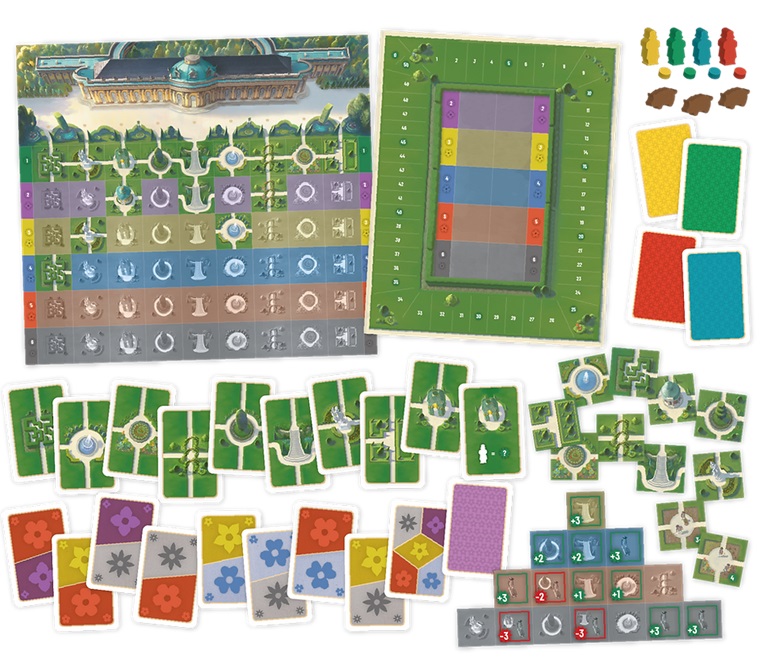Build a Garden and Go For a Walk Through Its Pathways in Sanssouci

Lay out beautiful paths throughout the garden, sending noblemen in different directions to admire the mazes, trees, and statues in an effort to build the most beautiful garden.
Published by Fractal Juegos and Imperial Publishing, Inc, Sanssouci is a 40-minute tile-laying game for 2-4 players.
Gameplay
Each player has a garden board. Each garden board has nine columns which are six rows long. Each column features a different garden structure type, such as a fountain or stairs, and each row features a different color. At the start of the game, each player puts a meeple at the top of each one of his garden columns.
On a player’s turn, he must play one of his two action cards. An action card either shows two colors, a structure type, or is wild. In the display, there are 10 garden tiles available, divided so that there are two associated with each of the garden row colors. If a player uses an action card that shows two colors, he chooses one of those colors and takes one of the tiles in that color’s section of the display. If he plays a structure card, he must take a tile showing that structure type from the display. If that structure type is not present in the display, he may take any one tile. The wild also allows him to take any one tile.
After taking a tile, the active player adds it to his garden board. It must be placed in the correct column based on the structure on the tile, and in the row whose color matches the section of the display the tile was drafted from. If there is already a tile in the spot the tile should go, the player flips if face-down to its gardener side and places it in any empty spot in its intended column or row.
Next, the active player may choose to move one of his meeples. The meeple may move through any connected tiles, but must end the turn on its starting column, and must also end the turn at least one row further down than where it started. It also may not end the turn on a tile showing its gardener side. The player then scores points for how far down the column the meeple is. The same meeple may be moved on multiple turns.
Afterwards, the player ends his turn by drawing a new tile for the display and drawing back up to two action cards.
Each player has eighteen turns in the game, after which players score points for each row fully filled with tiles (rows near the top of the garden board are worth more points for completing than rows further down) and five points for each completed column. Finally, each player has two mission cards, which score points for how far a meeple got down a specific column. The player with the most points wins.

Review
The puzzle of Sanssouci is quite interesting, as players try to connect tiles to make routes for their meeples, while also keeping an eye out for filling up rows and columns. Choosing how far to move a meeple is also key. Perhaps there is a path down to the final row, which will score six points, but if the meeple makes multiple stops, then it’s going to score multiple times. However, each player has nine meeples and only eighteen turns in which to move them, so opportunities to move each meeple are limited.
These choices all lead to interesting decisions, which gives a lot of weight to each turn while keeping those turns relatively fast. There’s not really any player interaction, but people do have some room for contemplating their next move while other players take their turns. The display is constantly changing, but since you only have a hand of two cards, there is some limit to how many options you have to consider.
There are also plenty of exceptions that open up your options. Holding a structure card that doesn’t match any of the tiles in the display suddenly turns it into a wild, or drafting a tile and being forced to flip it over to its gardener side. Gardeners can be more challenging for moving your meeples, but they are very beneficial for completing rows and columns.
Also, the fact that the higher rows are worth more points for completing, but the lower ones are worth more points for getting meeples to them, adds another layer to the gameplay as players balance between these two conflicting goals. No board is ever going to be completely filled — there simply aren’t enough rounds or tiles to do that. So, there is always going to be a trade-off with every tile placed, and that is the meat and heart of the game.
It does feel like the game misses an opportunity with the aesthetics. This is a game about building a garden, which should be beautiful to look at. Unfortunately, we felt that the artwork and visuals were rather bland. The components are also a bit lackluster. No part of the aesthetics of this game really stands out and grabs you.
Sanssouci is a think-y puzzle game. The scoring system isn’t too complicated, but it’s quite intriguing. It plays at a pretty good speed, and the result is an accessible, easy-to-teach game that has a lot of strategic decisions in it.
Pros: Good scoring system, fun tile-laying puzzle
Cons: The game and components look bland which is disappointing given the theme, no player interaction
Disclosure: we received a complimentary review copy of this game.







